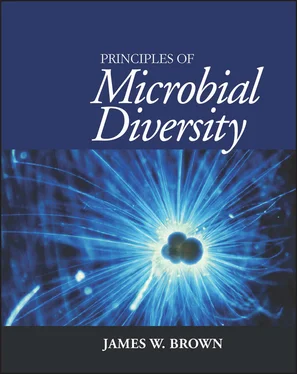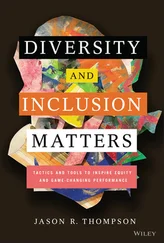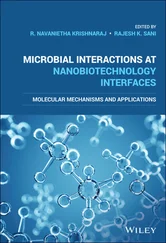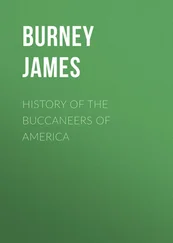1 Cover
2 Preface
3 Acknowledgments
4 About the Author
5 SECTION I: Introduction to Microbial Diversity In the well-known children’s story by Dr. Seuss, Horton the elephant discovers that a tiny speck of dust contains an entire world of creatures much too small for him to see .
1 What Is Microbial Diversity?
Facets of microbial diversity The fundamental similarity of all living things The fundamental similarity of all living things Before spending the rest of this book describing diversity, i.e., how organisms differ from one another, it is useful to remember and keep always in mind that all cells are fundamentally the same in almost every way . One way to view this is by walking through the flow of information in the cell—the “Central Dogma” (Fig. 1.10)—and point out the fundamental similarities common to all living things.
2 Context and Historical Baggage
The evolution of evolutionary thought The evolution of evolutionary thought The chain of being Well before people discovered that species changed over time, both living and nonliving things were organized (in Western culture, including Aristotle) into the “chain of being” (Fig. 2.1). All species and substances were placed onto individual slices of a vertical scale, ascending from “inferior” to “superior.” Much thought and energy were put into deciding exactly how to order the major categories of materials, living things, species, races, social classes, and even individuals onto this linear arrangement. (It will come as no surprise to the cynical that the ethnic group placed at the top of the human region of the chain generally matched that of whoever was organizing the chain.) This was an impossible task, with lots of problematic and contradictory issues. In retrospect, it is obvious that the reason for this was that there is no linear relationship between things in nature. As an aside, this linear arrangement of substances survives, in general form, in the periodic table, in which the elements are arranged in order of increasing Figure 2.1 The “chain of being,” with some representative organisms shown. To the right is a closer view of one thin slice of this “chain.” doi:10.1128/9781555818517.ch2.f2.1 atomic number. The chain is broken into segments, and the segments are stacked in such a way that elements with similar properties form columns. The reason this works is because elements are structured in a linear series based on atomic number.
Taxonomy and phylogeny Taxonomy and phylogeny A taxonomy is a classification scheme for species (or any other collection of objects, for that matter). There are three related components of a biological taxonomy: 1 1. Grouping: The organization of organisms into groups based on similarity 2 2. Naming: The labeling of organisms and groups of organisms with names 3 3. Identifying: The identification of organisms when they are found Taxonomies are artificial constructions, methods created and used by humans to organize species. Any self-consistent taxonomy is valid, whether it reflects the natural relationships of the organisms or not. For example, wildflower field guides organize species by features that are readily observed in the field. The first division might be by flower color, a trivial feature of the plants in evolutionary terms but perfectly reasonable for taxonomy. There is no implication that plants with flowers of the same color are related phylogenetically or that plants with flowers of different colors are not related. The field guide is designed for grouping, naming, and identifying species, and so are useful taxonomies. A phylogeny is the evolutionary pathway relating species. Think of a phylogeny as a large-scale genealogy of species. Phylogenies represent the actual natural relationships between organisms. They are most commonly displayed graphically in the form of phylogenetic trees. Unfortunately, there are generally no natural delineations between groups in a phylogenetic tree. However, taxonomists can start with a phylogenetic tree and try to divide it into reasonable groups based on the branches of the tree and the phenotypes of the organisms. In doing so, they attempt to devise a taxonomy that reflects, or at least is consistent with, the phylogenetic relationships between the species. The classical taxonomies of plants and animals are fairly good representations of the phylogenetic relationships between their members because the intricate morphology of these organisms reveals their ancestry. This is not true for microbes. There was no way to determine evolutionary relationships between Bacteria and Archaea or even between protists, algae, and fungi until the development of molecular phylogenetics, in which phylogenetic relationships are inferred on the basis of gene sequences.
The false eukaryote-prokaryote dichotomy 3 Phylogenetic Information Deciding which organisms and sequences to use in the analysis Obtaining the required sequence data Assembling sequences in a multiple-sequence alignment 4 Constructing a Phylogenetic Tree Tree construction: the neighbor-joining method How to read a phylogenetic tree Example analysis 5 Tree Construction Complexities Substitution models Treeing algorithms Bootstrapping 6 Alternatives to Small-Subunit rRNA AnalysisSSU rRNA cannot be used to distinguish closely related organisms Alternative sequences Alternatives to sequence-based methods 7 The Tree of Life Major lessons of the “Big Tree of Life” Rooting the “Tree of Life” The caveat of horizontal transfer
6 SECTION II: The Microbial Zoo 8 Primitive Thermophilic Bacteria Phylum Aquificae (Aquifex and relatives) Phylum Thermotogae (Thermotoga and relatives) Other primitive thermophiles Thermophilic ancestry of Bacteria Life at high temperatures 9 Green Phototrophic Bacteria Phylum Chloroflexi (green nonsulfur bacteria) Phylum Chlorobi (green sulfur bacteria) Phylum Cyanobacteria (blue-green algae) Other green phototrophs Bacterial photosynthesis Carbon fixation 10 ProteobacteriaPhylum Proteobacteria (purple bacteria and relatives) Class Alphaproteobacteria Class Betaproteobacteria Class Gammaproteobacteria Class Deltaproteobacteria Class Epsilonproteobacteria The concept of “proteobacteria” 11 Gram-Positive Bacteria What does being gram positive mean? An alternative view of gram-positive bacteria Phylum Firmicutes (low-G∙C gram-positive bacteria) Phylum Actinobacteria (high-G∙C gram-positive bacteria) Bacterial development Bacterial multicellularity 12 Spirochetes and Bacteroids Phylum Spirochaetae Phylum Bacteroidetes (sphingobacteria or Bacteroides/Flavobacterium/Cytophaga group) Bacterial motility 13 Deinococci, Chlamydiae, and Planctomycetes Phylum Deinococcus-Thermus Phylum Chlamydiae (Chlamydia and relatives) Phylum Planctomycetes (Planctomyces and relatives) Reductive evolution in parasites 14 Bacterial Phyla with Few or No Cultivated Species How do we know about these organisms? Phyla with few cultivated species Phyla with no cultivated species Phylogenetic groups at all levels are dominated by uncultivated sequences How much of the microbial world do we know about? 15 Archaea General properties of the Archaea Phylum Crenarchaeota Phylum Euryarchaeota Phylum Korarchaeota Phylum Nanoarchaeota Archaea as … 16 Eukaryotes General properties of the eukaryotes Unikonta Plantae Chromalveolata Rhizaria Excavata 17 Viruses and Prions Viruses Prions
7 SECTION III: Microbial Populations 18 Identification of Uncultivated Organisms 19 Sequence-Based Microbial Surveys 20 Fluorescent In Situ Hybridization SurveysFluorescent in situ hybridization Confocal laser scanning microscopy 21 Molecular Fingerprinting of Microbial Populations Denaturing gradient gel electrophoresis Terminal restriction fragment length polymorphism 22 Linking Phenotype and Phylotype The genomic or metagenomic approach The stable-isotope probing approach
Читать дальше












